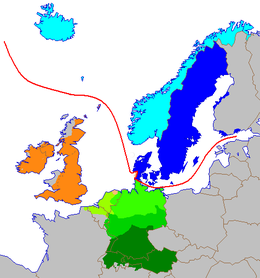| Revision as of 17:01, 5 July 2007 edit71.106.182.39 (talk) it is also referred to as Alto Adige in English, and the region is in Italy.← Previous edit | Revision as of 21:50, 5 July 2007 edit undoDelirium (talk | contribs)Administrators51,624 edits rv change by user who's on a mass spree to erase the name "South Tyrol" from Misplaced PagesNext edit → | ||
| Line 2: | Line 2: | ||
| {{Infobox Language family | {{Infobox Language family | ||
| |name=High German | |name=High German | ||
| |region=predominantly central and southern ], ], ], northern and central ], ], ], ] and ] |
|region=predominantly central and southern ], ], ], northern and central ], ], ], ] and ] | ||
| |familycolor=Indo-European | |familycolor=Indo-European | ||
| |fam1=] | |fam1=] | ||
Revision as of 21:50, 5 July 2007
| This article does not cite any sources. Please help improve this article by adding citations to reliable sources. Unsourced material may be challenged and removed. Find sources: "High German languages" – news · newspapers · books · scholar · JSTOR (November 2006) (Learn how and when to remove this message) |
| High German | |
|---|---|
| Geographic distribution | predominantly central and southern Germany, Liechtenstein, Luxembourg, northern and central Switzerland, Austria, Poland, Alsace and South Tyrol |
| Linguistic classification | Indo-European
|
| Subdivisions | |
| Language codes | |


The High German languages (in German, Hochdeutsch) are any of the varieties of standard German, Luxembourgish and Yiddish as well as the local German dialects spoken in central and southern Germany, Austria, Liechtenstein, Switzerland, Luxembourg and in neighbouring portions of Belgium, France (Alsace and northern Lorraine), Italy and Poland. The language is also spoken diaspora in Romania (Transylvania), Russia, the United States, Argentina and Namibia.
"High" refers to the mountainous areas of central and southern Germany and the Alps, as opposed to Low German spoken along the flat sea coasts of the north. High German can be subdivided into Upper German and Central German (Oberdeutsch, Mitteldeutsch).
The German term Hochdeutsch is also used loosely, but not by linguists, to mean standard written German as opposed to dialect, because the standard language developed out of High rather than Low German. This is based on a misunderstanding, and the attempt to rationalise it by suggesting that "high" means "official" doesn't solve the problem. In English, "High German" has never been used to mean "Standard German".
History
High German as used in Southern Germany, Bavaria and Austria was an important basis for the development of standard German.
The historical forms of the language are Old High German and Middle High German.
Classification
High German are distinguished from other West Germanic varieties in that they took part in the High German consonant shift (c. AD 500). To see this, compare German Pfanne with English pan ( to ), German zwei with English two ( to ), German machen with English make ( to ). In the High Alemannic dialects, there is a further shift; Sack (like English "sack") is pronounced ( to ).
Family tree
Note that divisions between subfamilies of Germanic are rarely precisely defined; most form continuous clines, with adjacent dialects being mutually intelligible and more separated ones not. In particular, there never has been an original "Proto-High German". For this and other reasons, the idea of representing the relationships between West Germanic language forms in a tree diagram at all is controversial among linguists; what follows should be used with care in the light of this caveat.
- Central German (German: Mitteldeutsch)
- East Central German
- Berlin Brandenburgish (mostly in Berlin and Brandenburg)
- Thuringian Upper Saxon (mostly in Thuringia, Saxony-Anhalt and Saxony)
- German Lusatian (in Saxony and Brandenburg)
- Lower Silesian (mostly in Lower Silesia, in Poland)
- Transylvanian Saxon (in Transylvania)
- West Central German
- Middle Franconian
- Ripuarian
- Moselle Franconian, including the Luxembourgish language
- Rhine Franconian
- Middle Franconian
- Transitional areas between Central German and Upper German
- Pennsylvania German (in the United States and Canada)
- East Central German
- Upper German (German: Oberdeutsch)
- Alemannic
- Swabian
- Low Alemannic (including one Swiss German dialect: Basel German)
- Alsatian language (but often also classified as within Low Alemannic)
- High Alemannic (including many Swiss German dialects)
- Highest Alemannic (including Swiss German dialects)
- Austro-Bavarian (On the use of dialects and Standard German in Austria, see Austrian language)
- Northern Austro-Bavarian (spoken in Upper Palatinate)
- Central Austro-Bavarian (includes the dialects of Upper Bavaria, Lower Bavaria, Upper Austria, Lower Austria and Vienna — see Viennese language)
- Southern Austro-Bavarian (includes the dialects of Tyrol, Carinthia and Styria)
- Cimbrian (northeastern Italy)
- Mócheno (Trentino, in Italy)
- Hutterite German (in Canada and the United States)
- Alemannic
- Yiddish
External links
- German dialects of today (in German)